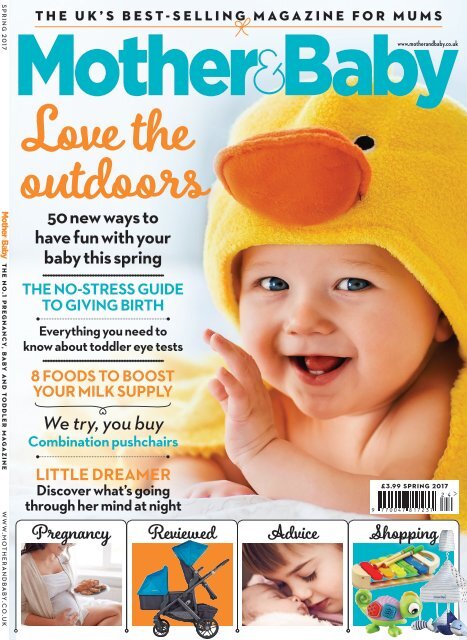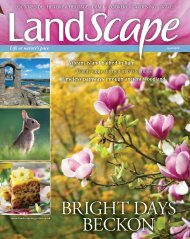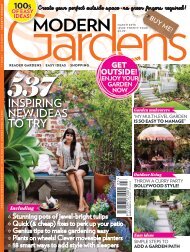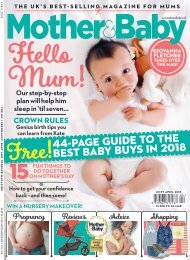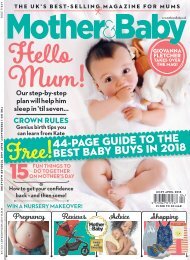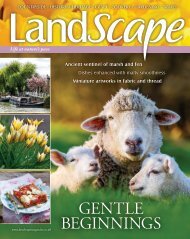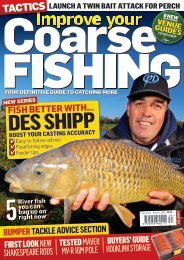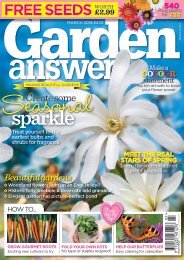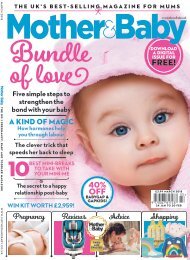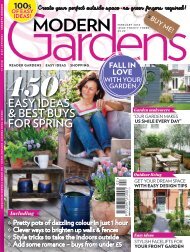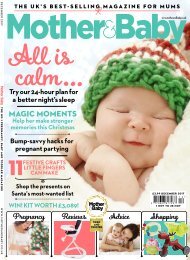Spring issue of Mother and Baby
You also want an ePaper? Increase the reach of your titles
YUMPU automatically turns print PDFs into web optimized ePapers that Google loves.
SPRING 2017 THE No.1 PREGNANCY, BABY AND TODDLER MAGAZINE<br />
WWW.MOTHERANDBABY.CO.UK<br />
www.mother<strong>and</strong>baby.co.uk<br />
THE UK’S BEST-SELLING MAGAZINE FOR MUMS<br />
Love the<br />
outdoors<br />
50 new ways to<br />
have fun with your<br />
baby this spring<br />
THE NO-STRESS GUIDE<br />
TO GIVING BIRTH<br />
Everything you need to<br />
know about toddler eye tests<br />
8 FOODS TO BOOST<br />
YOUR MILK SUPPLY<br />
We try, you buy<br />
Combination pushchairs<br />
LITTLE DREAMER<br />
Discover what’s going<br />
through her mind at night<br />
Pregnancy<br />
Reviewed<br />
Advice<br />
www.mother<strong>and</strong>baby.co.uk<br />
£3.99 SPRING 2017<br />
Shopping
Contents <strong>Spring</strong><br />
COVER ISTOCKPHOTO<br />
p36<br />
p58<br />
p106<br />
p61<br />
p47<br />
Upfront<br />
6 News <strong>and</strong> views<br />
Our round-up <strong>of</strong> essential<br />
parenting updates <strong>and</strong><br />
key trends<br />
18 Over to you<br />
Letters, photos, emails <strong>and</strong><br />
Facebook posts<br />
On the<br />
Cover<br />
p42<br />
p123<br />
86<br />
What your baby can<br />
teach you about love<br />
47<br />
Find out about your<br />
baby’s dreams<br />
Bump&Birth<br />
26 The first thing I bought<br />
for my baby<br />
Readers share happy memories<br />
30 Plus-size pregnancy<br />
sorted<br />
Clever tips <strong>and</strong> tricks<br />
32 Dress my bump<br />
Fashion for work <strong>and</strong> play<br />
34 Birth stories<br />
A vaginal birth after a c-section<br />
36 What it really feels like<br />
to give birth<br />
Our no-stress guide to labour<br />
<strong>Baby</strong>&Toddler<br />
42 Boost your breastmilk!<br />
Simple changes for quick results<br />
47 Sweet dreams<br />
Learn about her night-time musings<br />
52 Encourage her to be a<br />
chatterbox<br />
How to get your baby talking more<br />
58 Keep your eye on it<br />
Preparing your child for an eye test<br />
61 50 ways to have fun<br />
outdoors<br />
Try our fab h<strong>and</strong>s-on activities<br />
80 Line up!<br />
Stripes are on trend for kids<br />
Life&Kids<br />
86 Lessons in love<br />
What your baby can teach you<br />
90 Into the blue<br />
Rochelle Humes on nursery colours<br />
92 What are his animal<br />
instincts?<br />
Our fun quiz about being a dad<br />
95 Free nursery CD!<br />
Music to entertain your baby<br />
Here to help<br />
Our experts answer all your questions<br />
76 Pregnancy<br />
77 Behaviour<br />
78 Eating<br />
79 Sleeping<br />
4 | <strong>Spring</strong> 2017 | mother<strong>and</strong>baby.co.uk
42<br />
Boost your<br />
breastmilk<br />
61<br />
50 ways to have<br />
fun together in the<br />
spring sunshine<br />
Subscribe!<br />
Pay just £15 for seven<br />
<strong>issue</strong>s <strong>and</strong> get a welcome<br />
gift <strong>of</strong> NUK Feeding Set<br />
worth £49.99.<br />
See page 72.<br />
96 10 steps to a healthy<br />
spring<br />
Ways to welcome the new season<br />
98 Bunnylicious<br />
Yummy child-friendly Easter treats<br />
Shop!<br />
104 First look<br />
The latest must-have baby toys<br />
106 The big test<br />
Convertible pushchairs reviewed<br />
Join us online at<br />
mother<strong>and</strong>baby.co.uk<br />
Digital edition<br />
on sale now!<br />
Get M&B on the move,<br />
direct to your mobile or tablet.<br />
greatmagazines.co.uk<br />
113 Supermarket buys!<br />
What’s new in the aisles<br />
114 Six ways to enjoy<br />
tummy time<br />
Items to aid development<br />
115 Mum’s awards<br />
The best buys for your baby’s needs<br />
120 Giveaways<br />
Worth over £2,559<br />
122 20% <strong>of</strong>f at Polarn<br />
O. Pyret<br />
Exclusive <strong>of</strong>fer for M&B readers<br />
123 Chase the rainbow<br />
Multi-coloured designs to delight<br />
130 10 tips if you’re going to<br />
Center Parcs<br />
Prepare beforeh<strong>and</strong> for a top time<br />
106<br />
Convertible<br />
pushchairs<br />
tested by<br />
mums<br />
mother<strong>and</strong>baby.co.uk | <strong>Spring</strong> 2017 | 5
STRAIGHT TALKING<br />
What it<br />
really feels like to<br />
GIVE BIRTH<br />
It will be something like this, says mum-<strong>of</strong>-three Milli Hill<br />
CREDIT IN HERE<br />
When it comes to giving<br />
birth, most women’s<br />
bodies don’t conform<br />
exactly to set patterns.<br />
A labour may start slow,<br />
get fast, stall, do a bit<br />
more slow stuff, then get cracking like you’re<br />
riding the runaway horse in the Gr<strong>and</strong><br />
National. But if you’re pregnant for the<br />
first time, you’ve probably got one burning<br />
question at the forefront <strong>of</strong> your mind:<br />
‘What will it feel like?’ To try <strong>and</strong> help give<br />
you the answers, I’ve divided labour up into<br />
14 phases – yes, you heard me right, 14!<br />
Trying to conceptualise one <strong>of</strong> the most<br />
mind-blowingly unique experiences <strong>of</strong> your<br />
life by dividing it into sections is a bit like<br />
trying to describe your wedding day in terms<br />
<strong>of</strong> car journeys, or measuring out your life<br />
in c<strong>of</strong>fee spoons. In reality, all <strong>of</strong> these phases<br />
will probably blend <strong>and</strong> blur into each other.<br />
It will be different for you. But it will also be<br />
something like this...<br />
THE NOTHING DOING PHASE<br />
In the days <strong>and</strong> hours before labour begins,<br />
you might feel the increasing intensity <strong>of</strong> this<br />
phase. You’ll be bombarded by well-meaning<br />
friends asking, ‘Anything doing?’ You might<br />
feel like the answer is, ‘Nope, nothing to see<br />
here’, but in fact, the dance <strong>of</strong> hormones is<br />
almost certainly beginning, <strong>and</strong> there may be<br />
internal changes that you cannot see or feel,<br />
like your baby moving further into position or<br />
your cervix beginning to thin. It feels boring,<br />
frustrating, exciting, heavy, cumbersome<br />
<strong>and</strong> filled with anticipation. Some women feel<br />
physically really uncomfortable, others are<br />
energised <strong>and</strong> agile. Many start to feel small<br />
urges to withdraw from day-to-day life.<br />
MEET THE<br />
EXPERT<br />
Milli Hill is a mum <strong>of</strong><br />
three, author <strong>of</strong> The<br />
Positive Birth Book<br />
(£14.99, Pinter &<br />
Martin) <strong>and</strong> founder<br />
<strong>of</strong> The Positive Birth<br />
Movement.<br />
Win<br />
Want more<br />
advice from Milli?<br />
We’ve 10 copies<br />
<strong>of</strong> her new book,<br />
The Positive Birth<br />
Book (£14.99,<br />
Pinter & Martin)<br />
to give away. To<br />
enter (it’s free!),<br />
visit winit.mother<br />
<strong>and</strong>baby.co.uk<br />
by 18 April . See<br />
website for terms<br />
<strong>and</strong> conditions.<br />
THE MAYBE SOMETHING IS<br />
HAPPENING PHASE<br />
This can sometimes be your mind playing<br />
tricks on you due to your desperation to meet<br />
your baby – <strong>and</strong> be able to put on your<br />
own shoes again – but more <strong>of</strong>ten than not,<br />
it’s the beginning <strong>of</strong> little signs that birth is<br />
more <strong>and</strong> more imminent. You might<br />
experience an increase in Braxton Hicks,<br />
those tightenings in your bump that are<br />
like practice contractions. You might feel<br />
hormonal, perhaps with rushes <strong>of</strong> oxytocin<br />
which can make you feel very positive <strong>and</strong><br />
loved up, or adrenaline, which can make you<br />
decide that now would be a great time to<br />
launder your curtains. You might also lose<br />
your mucus plug, which is the little blob <strong>of</strong><br />
jelly that seals up your uterus. This will<br />
sometimes have a pinkish tinge <strong>and</strong> is also<br />
known rather romantically as a Bloody Show.<br />
It feels as if you are spiralling inwards,<br />
connected to your baby, <strong>and</strong> you might<br />
be nervous, excited <strong>and</strong> emotional.<br />
THE NIGGLING PHASE<br />
Midwives love this word: niggling. They use<br />
it to describe women in the very early part <strong>of</strong><br />
labour who are starting to feel those Braxton<br />
Hicks more strongly. The tightenings start<br />
to be harder to ignore <strong>and</strong> some women’s<br />
waters break. We could also call this the<br />
Yes, Something Is Finally Flipping Happening<br />
Phase, but it can be very ‘stop start’.<br />
THE RAMPING UP PHASE<br />
Slowly but surely, the niggling phase gives way<br />
to something that feels a bit different, as<br />
labour gathers pace <strong>and</strong> ramps up. You might<br />
find that the tightenings, surges or<br />
contractions dem<strong>and</strong> your full attention, <strong>and</strong><br />
that you begin to get into a rhythm or dance<br />
36 | <strong>Spring</strong> 2017 | mother<strong>and</strong>baby.co.uk
Bump&Birth<br />
with them. For example, each time you feel<br />
one approach you might lean on the chest <strong>of</strong><br />
drawers, rock back <strong>and</strong> forward, moan <strong>and</strong><br />
work your way through it until you feel it<br />
subside again. Then you might carry on with<br />
what you were doing. Between surges you will<br />
feel completely normal <strong>and</strong> <strong>of</strong>ten very energised,<br />
happy, or even a bit ‘trippy’ from the hormonal<br />
experience. If you’re not giving birth at home,<br />
you will probably travel during this phase.<br />
It feels exciting, dream-like, intensifying,<br />
rhythmical, powerful <strong>and</strong> like<br />
you are definitely going to have<br />
a baby!<br />
THE CRACKING<br />
ON PHASE<br />
Hold on to your hat, this is<br />
when it really gets interesting!<br />
You are totally, fully <strong>and</strong><br />
unmistakably in the thickest, fullest<br />
<strong>and</strong> most intense part <strong>of</strong> labour. Your<br />
contractions will probably come more<br />
frequently, be more intense <strong>and</strong> last<br />
longer. You will probably not feel like<br />
talking or doing anything else. You will<br />
be in the place that some people call<br />
‘Labour L<strong>and</strong>’, utterly focused on<br />
riding the waves <strong>and</strong> staying afloat.<br />
Many people do find this part <strong>of</strong> labour<br />
really hard work <strong>and</strong> really intense. There<br />
is still some <strong>of</strong> the golden time between<br />
contractions, but they are closer together,<br />
<strong>and</strong> the peaks <strong>of</strong> them can be, well, cracking.<br />
TRANSITION PHASE<br />
I’ve deliberately not talked about dilation up<br />
till now because I really want to discourage you<br />
from worrying about measuring the opening<br />
<strong>of</strong> your cervix in centimetres <strong>and</strong> focus<br />
instead on the experience <strong>of</strong> being in<br />
labour. However, transition means you’ve<br />
reached full dilation, which is roughly<br />
around 10cm, the size <strong>of</strong> a box <strong>of</strong> cheese<br />
triangles. Transition is a time when<br />
everything changes. You will feel this,<br />
<strong>and</strong> it will be happening in your<br />
hormones as oxytocin makes way for<br />
the adrenaline you need to wake you<br />
up from Labour L<strong>and</strong>, <strong>and</strong> energise<br />
you enough to give birth. This<br />
hormonal shift may even cause you<br />
to feel ‘fear’ at this moment, but<br />
this doesn’t mean that you<br />
cannot do it. It just means<br />
you are doing it. This<br />
stage can feel hugely<br />
emotional, but<br />
although it’s intense,<br />
it’s usually brief: it is<br />
like a wave <strong>of</strong> feelings that will wash over you<br />
<strong>and</strong> then pass away, as all waves do.<br />
THE REST AND BE<br />
THANKFUL PHASE<br />
This doesn’t happen for all women,<br />
but some experience a pause<br />
here. For some it lasts long<br />
enough to cause care<br />
providers concern that<br />
labour has stalled.<br />
More <strong>of</strong>ten than not,<br />
it hasn’t, <strong>and</strong> after<br />
these moments <strong>of</strong><br />
gathering in<br />
fortitude <strong>and</strong><br />
courage, the<br />
majority <strong>of</strong><br />
women make<br />
SHARE<br />
YOUR<br />
STORY<br />
Tell us<br />
about your<br />
experience<br />
<strong>of</strong> a c-section<br />
facebook.com/<br />
mother<strong>and</strong>baby
MAKE MORE MILK!<br />
WORDS LOUISE PYNE PHOTOGRAPHY GETTY, SHUTTERSTOCK<br />
BOOST<br />
Breastmilk!<br />
YOUR<br />
Make some simple changes to what you eat for<br />
near-instant results, says nutritionist Louise Pyne<br />
42 | <strong>Spring</strong> 2017 | mother<strong>and</strong>baby.co.uk
<strong>Baby</strong>&Toddler<br />
If you’re breastfeeding, filling up on<br />
nutritious food is just as important as<br />
it was during pregnancy. Smartening<br />
up your diet <strong>and</strong> fine-tuning meals <strong>and</strong><br />
snacks to include specific ingredients<br />
will increase the quantity <strong>and</strong> quality<br />
<strong>of</strong> your breastmilk supply. So put your diet<br />
plans on hold <strong>and</strong> focus on making it as easy<br />
as possible for your body to do its next vital<br />
job. Because during the first month or so<br />
post-birth, while your body is getting used<br />
to meeting your baby’s constant nutritional<br />
needs, you may feel hungrier than usual.<br />
And although you might be thinking it would<br />
be good to get out <strong>of</strong> your maternity clothes<br />
<strong>and</strong> back into your pre-pregnancy wardrobe,<br />
this isn’t the time to cut back on calories.<br />
Breastfeeding can burn up to 500 calories per<br />
day, so listen to those hunger cues <strong>and</strong> make<br />
MEET THE<br />
EXPERT<br />
Louise Pyne<br />
is a registered<br />
nutritionist with<br />
a special interest<br />
in the health <strong>of</strong><br />
women <strong>and</strong> children,<br />
louisepyne<br />
nutrition.com<br />
up this deficit by upping your total daily intake<br />
to 2,500 calories to give both you <strong>and</strong> your<br />
baby the energy you need. Liquids are crucial<br />
too. Your breastmilk is between 80 <strong>and</strong> 90 per<br />
cent water, so it’s no surprise that drinking<br />
extra H 2 O will help maintain your supply.<br />
In addition to the usual 1.5 litre a day, if<br />
you’re breastfeeding you should be slurping<br />
another 800ml (four large glasses). Your<br />
body will help you remember: the hormone<br />
oxytocin released during feeds makes you<br />
feel thirsty. And watch out for signs <strong>of</strong><br />
dehydration: dark-coloured urine, dry lips <strong>and</strong><br />
muscle cramps. Liven up a glass <strong>of</strong> water with<br />
lemon wedges or cucumber slices, <strong>and</strong> keep<br />
a bottle <strong>of</strong> water by your bed <strong>and</strong> in the living<br />
room as a reminder to drink. Now discover<br />
the key ingredients you can add to your diet<br />
to make your milk the cream <strong>of</strong> the crop.<br />
ADD FLAVOUR<br />
EAT<br />
STRESS-RELIEVING<br />
FOODS<br />
It’s normal to feel a little anxious as you<br />
<strong>and</strong> your baby both get the hang <strong>of</strong><br />
breastfeeding, but feeling stressed<br />
can be counterproductive. Although<br />
the stress hormone cortisol is naturally<br />
found in breastmilk, high concentrations<br />
may lower milk supply. Be proactive,<br />
though, <strong>and</strong> your diet can help you<br />
manage your stress levels. Foods rich<br />
in the anti-anxiety nutrient magnesium<br />
can help trigger the release <strong>of</strong><br />
happiness-inducing neurotransmitters<br />
in the brain, which can quell extra-high<br />
cortisol levels. Dark green leafy veg,<br />
such as spinach, <strong>and</strong> raw nuts are best<br />
to calm your nerves. Whizz together<br />
200ml coconut water, half an avocado,<br />
50g spinach, 1 tbsp sunflower seeds<br />
<strong>and</strong> a h<strong>and</strong>ful <strong>of</strong> blueberries to make<br />
the ultimate magnesium-rich no-stress<br />
smoothie. Then sit back <strong>and</strong> enjoy<br />
a delicious drink that will also help<br />
you relax <strong>and</strong> feel calmer.<br />
You might be avoiding strong flavours while you’re<br />
breastfeeding, but certain tastes can make your baby feed<br />
longer. When a study compared breastfeeding mothers<br />
taking a garlic pill with another group<br />
taking a placebo, the infants exposed<br />
to garlic-flavoured milk sucked<br />
harder <strong>and</strong> nursed for longer. So<br />
put garlic bread back on the menu<br />
<strong>and</strong> see if your baby likes it too!<br />
Try this!<br />
Every time<br />
you refill the<br />
clever Joseph<br />
Joseph Dot<br />
Tracking Water<br />
Bottle,<br />
a dot is<br />
revealed on<br />
the lid, so you<br />
can easily<br />
keep track<br />
<strong>of</strong> how much<br />
you’re<br />
drinking.<br />
It’s amazing<br />
how dots<br />
can motivate<br />
you to drink<br />
more! £9.99,<br />
lakel<strong>and</strong>.<br />
co.uk<br />
UP YOUR<br />
CALCIUM INTAKE<br />
There’s no hard <strong>and</strong> fast rule for when<br />
periods restart after giving birth – for<br />
some women it’s a month afterwards,<br />
for others it can be up to a year.<br />
But when your cycle returns, you may<br />
experience a drop in milk supply prior<br />
to your period <strong>and</strong> for the first few days<br />
into one. It’s thought that increasing<br />
calcium <strong>and</strong> magnesium intake from<br />
the time <strong>of</strong> ovulation through to the<br />
third day <strong>of</strong> your period may help <strong>of</strong>fset<br />
this. A 200ml glass <strong>of</strong> skimmed milk<br />
has 34 per cent<br />
<strong>of</strong> your daily<br />
calcium intake.<br />
See Eat Stress-<br />
Relieving Foods,<br />
left, for tips on<br />
getting enough<br />
magnesium.<br />
mother<strong>and</strong>baby.co.uk | <strong>Spring</strong> 2017 | 43
HAPPY TALK<br />
Encourage her to be a<br />
CHATTERBOX<br />
From the get-go, there’s lots you can do to get your<br />
child talking more <strong>and</strong> aid her development<br />
52 | <strong>Spring</strong> 2017 | mother<strong>and</strong>baby.co.uk
<strong>Baby</strong>&Toddler<br />
MEET THE<br />
EXPERT<br />
Kate Freeman<br />
is a speech <strong>and</strong><br />
language therapist.<br />
She’s the lead<br />
advisor for children<br />
<strong>and</strong> families for<br />
I CAN, a children’s<br />
communication<br />
charity, ican.org.uk<br />
As a mum, having a good old<br />
natter is what keeps us feeling<br />
sane. And there are lots <strong>of</strong><br />
benefits for your youngster<br />
from chatting too. Early<br />
language skills act as a great<br />
foundation for the development <strong>of</strong> other skills<br />
later on, <strong>and</strong> a recent report by Save the<br />
Children revealed that chatter in the formative<br />
years is the most important factor for influencing<br />
literary levels at secondary school. Oh, <strong>and</strong><br />
having a little one who’s happy to chat with<br />
you about this, that <strong>and</strong> everything is great fun<br />
too – <strong>and</strong> will help your bond stay strong as<br />
she grows <strong>and</strong> becomes more independent.<br />
Like every other essential life skill, there’s<br />
a huge spectrum when it comes to who starts<br />
chatting when, <strong>and</strong> how quickly their language<br />
develops. But whether your baby or toddler is<br />
a natural chatterbox or has a little less to say<br />
than most, all children can be encouraged to<br />
communicate more. And whatever your child’s<br />
age, your starting point is making time to chat.<br />
‘Our lives are busy as parents, so it’s important<br />
to focus on face-to-face time talking with your<br />
child,’ says pre-school speech <strong>and</strong> language<br />
expert Kate Freeman. So ask yourself, do you<br />
really listen to your child when she chats to you,<br />
even if she’s just babbling right now? Do you<br />
stop what you’re doing, give her eye contact, <strong>and</strong><br />
take the time to respond? It’s easy to treat your<br />
child’s chatter as background noise while you<br />
focus on doing something else, <strong>and</strong> this is fine<br />
some <strong>of</strong> the time: but not all <strong>of</strong> the time. She<br />
needs to know you value her communication<br />
skills, as much as she values yours.<br />
And you can’t start doing this too soon,<br />
because your child’s chatterbox skills begin<br />
to develop early on in her life. Way before she<br />
learns the language <strong>of</strong> words <strong>and</strong> sentences,<br />
your baby underst<strong>and</strong>s about, <strong>and</strong> then starts<br />
to make, sounds. ‘Your baby will pay attention<br />
to the sounds around her <strong>and</strong>, eventually,<br />
start to not only underst<strong>and</strong> them but<br />
begin to link them with actions, objects<br />
<strong>and</strong> concepts,’ says Kate. ‘So, for example,<br />
she might realise that the ping <strong>of</strong> the<br />
microwave means that dinner is ready, or<br />
that the dog barking means that Dad has<br />
arrived home. At the same time, she starts to<br />
use her mouth <strong>and</strong> tongue in a co-ordinated<br />
way, gradually gaining more control.<br />
Eventually, she reaches the moment when she<br />
realises the sounds she’s making get a response,<br />
<strong>and</strong> this is how she starts to underst<strong>and</strong> the<br />
art <strong>of</strong> conversation. And it’s then that you’ll<br />
start to hear magical sounds like “Mama”.’<br />
TIME TO CHAT<br />
Simply getting down on the floor <strong>and</strong> playing<br />
with your child will encourage her to speak<br />
more. Focus on her favourite toys <strong>and</strong> let her<br />
take the lead. ‘Take the time to notice what<br />
she’s looking at, <strong>and</strong> talk about that,’ Kate<br />
advises. ‘So if it’s a teddy bear, for example,<br />
you could chat with her about what he looks<br />
like, or whether you think Ted might be tired<br />
or thirsty. Questioning less, <strong>and</strong> commenting<br />
more, will mean you avoid quizzing your child<br />
<strong>and</strong> encourage conversation instead. So you<br />
might say, “Ooh, let’s put Teddy to bed”<br />
rather than asking “What’s Teddy going to do<br />
now?” A good rule <strong>of</strong> thumb is to aim for four<br />
comments to every question.’ And during your<br />
little in-play chats, let your language be guided<br />
by the level <strong>of</strong> hers. ‘Talk to your child in<br />
short sentences, one word longer than her<br />
‘Hello!’<br />
mother<strong>and</strong>baby.co.uk | <strong>Spring</strong> 2017 | 53
Bunnylicious<br />
Easter treats for youngsters that<br />
are worth rabbiting about!<br />
MEET THE<br />
EXPERT<br />
Annabel Karmel<br />
is a children’s<br />
food expert,<br />
bestselling author<br />
<strong>and</strong> mum <strong>of</strong> three.<br />
Bunny banana porridge<br />
Prep: 5 minutes<br />
Cook: 5 minutes<br />
Makes: 1 portion<br />
Method<br />
1 Measure the oats <strong>and</strong> milk<br />
into a saucepan. Stir over<br />
the heat until boiling <strong>and</strong><br />
thickened. Add the banana<br />
<strong>and</strong> maple syrup (if using).<br />
SUITABLE<br />
FROM<br />
9 MONTHS<br />
2 Pour into a bowl <strong>and</strong> decorate<br />
with mini banana ears, banana<br />
<strong>and</strong> blueberries for the bunny’s<br />
eyes, strips <strong>of</strong> apple for the<br />
whiskers <strong>and</strong> teeth, <strong>and</strong> a<br />
strawberry for the nose.<br />
Ingredients<br />
● 50g porridge<br />
oats<br />
● 300 ml milk<br />
● 1 banana,<br />
mashed<br />
● 1 tbsp maple<br />
syrup (optional)<br />
Decoration<br />
● Mini bananas<br />
● Blueberries<br />
● Red apple<br />
● Strawberry<br />
98 | <strong>Spring</strong> 2017 | mother<strong>and</strong>baby.co.uk
SUITABLE<br />
FROM<br />
9 MONTHS<br />
Ingredients<br />
● 2 slices brown<br />
bread<br />
● 60g cream<br />
cheese<br />
● 1 baby cucumber,<br />
sliced<br />
● 2 slices from<br />
a small carrot<br />
● A few pea shoots<br />
Bunny<br />
bread<br />
Prep: 10 minutes<br />
Makes: 1 bunny bread<br />
Method<br />
1 Spread the slices <strong>of</strong> bread<br />
with the cream cheese.<br />
Cut out a large circle using<br />
a round cutter for the body.<br />
Cut out a smaller circle for<br />
the head <strong>and</strong> stamp out two<br />
small circles for the paws.<br />
2 Arrange the circles to<br />
form a bunny on the plate.<br />
Put two cucumber slices on<br />
top <strong>of</strong> the paws. Place two<br />
half slices <strong>of</strong> cucumber for<br />
the back paws. Cut two<br />
lengths <strong>of</strong> cucumber to<br />
make the ears.<br />
3 Decorate the face with<br />
the slices <strong>of</strong> carrot for the<br />
eyes <strong>and</strong> a pea shoot for<br />
the mouth.<br />
Sweet potato<br />
bunnies<br />
Prep: 10 minutes<br />
Cook: 30 minutes<br />
Makes: 4 bunnies<br />
Method<br />
1 Preheat the oven to 350°F/180°C/<br />
gas mark 4.<br />
2 Line a baking sheet with non-stick paper.<br />
3 Peel the sweet potato, then slice four<br />
thick slices about 1 cm thick using a metal<br />
bunny cutter. Stamp out one bunny from<br />
each slice. You may need<br />
to bang the cutter with<br />
a mallet if it is hard to push<br />
through the potato.<br />
4 Arrange on a baking sheet,<br />
drizzle with oil <strong>and</strong> season.<br />
5 Bake for 30 minutes, turning<br />
over half way through until<br />
lightly golden <strong>and</strong> cooked.<br />
6 Decorate with chives<br />
for whiskers.<br />
SUITABLE<br />
FROM<br />
9 MONTHS<br />
Ingredients<br />
● 1 large sweet<br />
potato<br />
● A little olive oil<br />
● Salt <strong>and</strong> pepper<br />
Decoration<br />
● Chives<br />
FUN WITH<br />
FOOD<br />
For more<br />
family meal<br />
inspiration <strong>and</strong><br />
healthy-eating<br />
guides, head to<br />
mother<strong>and</strong>baby.<br />
co.uk/food<br />
mother<strong>and</strong>baby.co.uk | <strong>Spring</strong> 2017 | 99
THE BIG<br />
TEST<br />
CONVERTIBLE<br />
PUSHCHAIRS<br />
Plan for the future with a pushchair<br />
that grows with your family<br />
WORDS HEIDI SCRIMGEOUR<br />
So what’s a convertible pushchair, you ask?<br />
Well, it’s not a mode <strong>of</strong> luxury open-air<br />
transport for your baby, instead it’s a clever<br />
future-pro<strong>of</strong> option suitable for one child,<br />
two <strong>of</strong> different ages or twins. It converts from<br />
a single pushchair to a t<strong>and</strong>em by attaching a<br />
second infant car seat, carrycot or upright seat.<br />
Beforeh<strong>and</strong>, you needed to buy a single pram<br />
for your first baby, then trade it in for a double<br />
if your family grew – but not any more!<br />
Do you need one?<br />
A convertible is a good choice if you’re buying<br />
a single pushchair for one child, but hope<br />
to have another baby in the not-too-distant<br />
future. And if you’re already pregnant with<br />
number two <strong>and</strong> will need a double pushchair<br />
for carrying two children together, a convertible<br />
is still a great idea as they’re generally lighter<br />
<strong>and</strong> more manoeuvrable than traditional<br />
side-by-side double buggies. Convertibles<br />
are also more flexible, because they <strong>of</strong>fer<br />
lots <strong>of</strong> different seating configurations,<br />
from a pushchair seat for a toddler alongside<br />
a carrycot or infant car seat for a younger<br />
baby, to two pushchair seats for siblings –<br />
<strong>and</strong> even two carrycots for twins. And once<br />
your older child no longer needs a ride,<br />
a convertible also gives you the option to<br />
revert to a streamlined single pushchair<br />
by detaching one <strong>of</strong> the seat units.<br />
Will it be in <strong>and</strong> out <strong>of</strong> your car boot?<br />
Some convertibles fold up with the seat units<br />
attached, making them really straightforward<br />
to move in <strong>and</strong> out <strong>of</strong> your car boot. But<br />
others require you to remove the seats from<br />
the pushchair chassis before you fold it.<br />
Depending on the size <strong>of</strong> your car boot,<br />
This month’s<br />
testers<br />
Kirsty McManus<br />
22, from East Kilbride, is<br />
mum to Harrison, eight<br />
weeks. ‘We’re hoping to<br />
add to our family, so we<br />
need a pushchair that will<br />
convert to a t<strong>and</strong>em.’<br />
Nicola Ricketts<br />
27, from West Yorkshire,<br />
is mum to Harleigh,<br />
two weeks, Parker,<br />
two, <strong>and</strong> Paige, four.<br />
‘I need one I can use as<br />
a single or t<strong>and</strong>em.’<br />
Michelle McCann<br />
37, from Brighton, is mum<br />
to Jude, one, Luke, two,<br />
<strong>and</strong> Isobel, seven.<br />
‘I need a compact buggy<br />
for both boys that I can<br />
take on a bus easily.’<br />
you might need to store the pushchair seat<br />
or carrycot on the back seat <strong>of</strong> your car,<br />
leaving less room for other passengers.<br />
How much have you got to spend?<br />
Convertibles vary enormously in price.<br />
Generally speaking, the more expensive<br />
models have a higher specification <strong>and</strong> a<br />
much more luxurious finish. But don’t rule<br />
out a convertible just because your budget<br />
can’t stretch to the top <strong>of</strong> the range: a less<br />
expensive option can still provide the<br />
flexibility you need. But do bear in<br />
that a convertible will be used for longer<br />
than the normal life cycle <strong>of</strong> a st<strong>and</strong>ard single<br />
pushchair so, whatever the price, it should<br />
feel sturdy <strong>and</strong> robust, <strong>and</strong> up to the task <strong>of</strong><br />
carrying two children at once for several years.<br />
How <strong>of</strong>ten will you convert it?<br />
Some convertible pushchairs are really easy<br />
to switch from single to t<strong>and</strong>em mode – it’s<br />
as simple as attaching or detaching a second<br />
seat at the touch <strong>of</strong> a button. Others have<br />
more complex mechanisms that necessitate<br />
adjusting part <strong>of</strong> the pushchair chassis.<br />
Think about how <strong>of</strong>ten you’ll want to change<br />
the configuration <strong>of</strong> the pushchair or adjust<br />
the seating positions.<br />
Our<br />
testers<br />
represent a range<br />
<strong>of</strong> ages that will use<br />
a convertible<br />
pushchair.<br />
Will you still like it<br />
in two years?<br />
It’s important<br />
that you love<br />
the way your<br />
pushchair looks<br />
<strong>and</strong> feels, because<br />
you’ll be using it<br />
for years to come!<br />
106 | <strong>Spring</strong> 2017 | mother<strong>and</strong>baby.co.uk
CARRYCOT<br />
A carrycot is<br />
suitable from birth <strong>and</strong> lets<br />
your baby lie completely flat.<br />
Babies outgrow carrycots<br />
quickly, so a pushchair seat with a<br />
lie-flat recline feature might be<br />
better value for money, but<br />
check that it’s suitable<br />
from birth.<br />
SEAT<br />
POSITION<br />
With some<br />
convertibles you can<br />
choose the direction the<br />
seats face. Parent-facing is<br />
best for interaction but<br />
older babies might like<br />
facing forwards.<br />
SUN<br />
CANOPY<br />
This helps protect<br />
your baby from the sun<br />
<strong>and</strong> wind. Check how far it<br />
extends <strong>and</strong> whether it<br />
gives full coverage,<br />
especially when the<br />
seat is reclined.<br />
Shop!<br />
HANDLEBAR<br />
A height-adjustable<br />
h<strong>and</strong>lebar is better: check<br />
how easy it is to alter for you,<br />
your partner <strong>and</strong> any relative<br />
who will use the pushchair<br />
regularly – <strong>and</strong> can you do<br />
so with one h<strong>and</strong><br />
if needed?<br />
HARNESS<br />
AND BUCKLES<br />
Strapping two<br />
children into a pushchair<br />
at once can be tricky.<br />
Check that you can<br />
fasten <strong>and</strong> undo the<br />
buckles easily.<br />
SUSPENSION<br />
Check the ride feels<br />
smooth enough for<br />
your baby to nap without<br />
being jolted awake.<br />
Think about whether her<br />
cheeks will wobble over<br />
cobblestones?<br />
TRAVEL<br />
SYSTEM<br />
Many convertibles let<br />
you attach your baby’s car<br />
seat to the pushchair chassis,<br />
so you can move your baby from<br />
car to pushchair more easily.<br />
Check which car seats are<br />
compatible <strong>and</strong> whether<br />
you need adaptors.<br />
ACCESSORIES<br />
Some pushchairs<br />
come with accessories<br />
such as a footmuff or rain<br />
cover. Check which ones<br />
you need, <strong>and</strong> whether<br />
they’re included.<br />
SHOPPING<br />
BASKET<br />
The basket should<br />
hold everything you need,<br />
including the rain cover <strong>and</strong><br />
your change bag. And two<br />
babies equal more stuff!<br />
Is the basket accessible<br />
when a second seat<br />
is in use?<br />
BRAKE<br />
Some are<br />
foot-operated but<br />
others are controlled by<br />
a lever on the h<strong>and</strong>lebar.<br />
Does it feel reliable,<br />
<strong>and</strong> can you apply<br />
it <strong>and</strong> release<br />
it easily?<br />
WHEELS<br />
Swivel wheels give<br />
good manoeuvrability<br />
over smooth ground such as<br />
pavements, but lockable wheels<br />
h<strong>and</strong>le country walks. Inflatable<br />
tyres ensure a smooth ride but<br />
may require a puncture repair<br />
kit, whereas hard tyres<br />
are more resilient.<br />
mother<strong>and</strong>baby.co.uk | <strong>Spring</strong> 2017 | 107
Like me?<br />
... try me!<br />
CLICK HERE TO SUBSCRIBE FOR<br />
AS LITTLE AS £15, PLUS RECEIVE<br />
AN AMAZING WELCOME GIFT!


